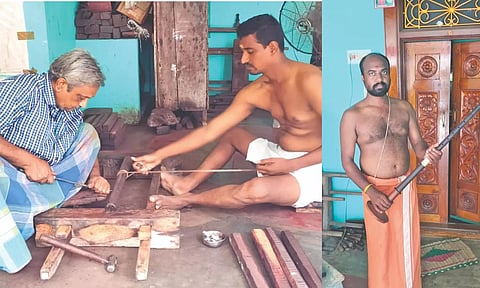

THANJAVUR: While the classical music fraternity is busy organising festivals during the Tamil month of ‘Margazhi’ to showcase their talent and quench the thirst of music lovers, there is a different story, rather a sorry tale, emerging from the instrument makers of the region.
Festivals are held in grandeur, but these professionals who make the instruments that resonate throughout this auspicious month are unfortunately struggling for their livelihood. They wait for support from the government to continue with their profession.
Thanjavur, termed to be the cultural headquarters of Tamil Nadu, is also famous for many classical instruments, especially the ‘Narasingampettai Nadhaswaram’, which stands on top among a few such instruments.
Nadhaswaram, considered to be the royal instrument from 17th century, can play both ‘Prathi Madhyamam Swaram’ and ‘Shuddha Madhyamam Swaram’. In the early days, one could play only ‘Prathi Madhyamam’ as playing the ‘Shuddha Madhyamam Swaram’ was considered difficult.
However, everything changed in due course of time as soon as NGN Ranganatha Achary from Narasingampettai tried both ‘Swarams’ during the early 40s and he made the Nadhaswaram capable of playing ‘Shuddha Madhyamam Swaram’ and presented it to the Nadaswara Chakravarthy Rajarathinam Pillai, who accredited the latest invention.
When India gained independence on August 15, 1947, Rajarathinam Pillai played ‘Nadhaswaram’ in ‘Shanmugapriya Ragam’ during the Independence Day celebrations in Delhi. And thus the ‘Narasingampettai Nadhaswaram’ became popular and is now widely used across the globe among the music fraternity.
Ranganatha Achary’s grandson NRS Satheesh makes the ‘Nadhaswaram’ and exports them to Australia, Singapore, Canada, and Malaysia where the Tamil diaspora resides in large numbers. This apart, the musicians from Kerala, Karnataka, and Andhra Pradesh are also purchasing the instruments.
“We select the first quality Karungali tree (ebony tree or black wood) from places like Karaikudi, Chettinad, Tiruvannamalai, and Panruti. The barks would be neatly cut for 28 inches and carved as a cylindrical shape and churned in such a way to make 12 Brahmastram and create both ‘Prathi Madhayamam’ and ‘Shuddha Madhyamam’,” explains Satheesh.
Thereafter, the other parts of the ‘Nadhaswaram’ would be made. “We take at least three days to complete a Nadhaswaram and a minimum of four persons are involved in making one. Thus, we could make five to six Nadhaswarams a month. We earn between Rs 3,500 and Rs 6,000 per piece,” he said.
Satheesh has been making the same model made by his grandfather till today for its quality and rendering of quality music.
Though the ‘Narasingampettai Nadhaswaram’ got the GI tag in 2022, the number of people involved in making the instrument has been declining year by year.
“Till recently, there were 12 families involved in making the instrument but currently only four families are manufacturing the instrument. This is due to poor support from the government, rise in material costs, and no loan facility despite being a cottage industry.”